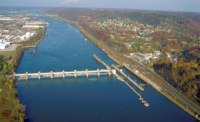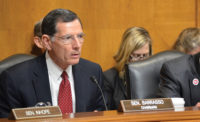
The first major water-resources bill in more than six years is heading to President Obama's desk. The $12.3-billion Water Resources Reform and Development Act authorizes nearly three dozen new Army Corps of Engineers projects, directs the agency to speed up its feasibility studies and provides new revenue sources for dredging, flood control and other water projects.
WRRDA focuses on the Corps, but it also aids water and wastewater-treatment projects, partly through changes in the U.S. Environmental Protection Agency state revolving fund program, or SRF.
WRRDA gained final congressional approval on May 22, when the Senate approved it by a strong 91-7 vote. The House cleared it two days earlier, 412-4.
"This is the biggest piece of water-resources legislation to come out of Congress in many years," says Jimmy Christianson, director of the Associated General Contractors of America federal and heavy construction division.
The bill authorizes 34 new Corps projects whose federal funding shares total $15.6 billion. The Congressional Budget Office estimates WRRDA's 10-year cost at $12.3 billion, but notes that the projects' schedules and costs will stretch well beyond a decade. Though the measure specifies projects and funding, lawmakers maintain that it has no earmarks, and it also deauthorizes $18 billion in old, inactive projects.
Even with the authorizations, the new projects still will require annual appropriations. Competition will be fierce for those limited dollars. Jim Walker, American Association of Port Authorities director of navigation policy and legislation, says, "Having the authorization hurdle cleared, now we'll be moving on to the appropriations bill and looking to see those [projects] get started."
Dredging is a big winner in WRRDA. Besides authorizing eight port-dredging projects, it seeks to boost spending from the Harbor Maintenance Trust Fund, in steps, until 2025, when annual outgo will equal the fund's income from a maritime freight fee. John Doyle, special counsel with law and lobbying firm Jones Walker LLP, says that "should add significant additional dollars in the very short term—this year and next at a minimum—for dredging-related activities."
Another provision will benefit river projects. WRRDA changes funding for the Olmsted Locks and Dam project on the Ohio River to 85% from the general fund and 15% from the Inland Waterways Trust Fund, from 50-50 now. Industry officials have complained that as Olmsted's cost rose to $2.9 billion from $775 million in 1987, it swallowed up trust-fund dollars that other projects desired. Mike Toohey, Waterways Council Inc. CEO, estimates that WRRDA will free an added $105 million a year for non-Olmsted work.
To draw more private funds to water projects, WRRDA creates a Water Infrastructure Finance and Innovation Act pilot program (WIFIA) to provide federal loans and loan guarantees for Corps civil works and EPA wastewater-treatment and drinking-water projects.
Modeled on the Transportation Dept.'s 16-year-old TIFIA program, WIFIA gets $375 million over five years, subject to appropriations. Funds are divided between the Corps and EPA. "I think you're going to see private funds coming in and leveraging against the public funds," says House Transportation and Infrastructure Committee Chairman Bill Shuster (R-Pa.), a main WRRDA author. The bill also establishes a pilot program allowing public-private partnerships for "at least 15" Corps projects.




